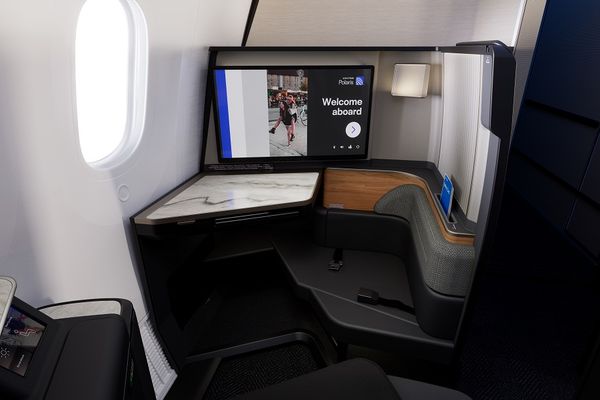An Ethiopian Airlines De Haviland Canada DHC-8 (Dash 8) aircraft suffered severe damage after a crash landing at Mekelle Airport (MQX) in northern Ethiopia on January 18. The aircraft was operating Ethiopian Airlines flight 106 (ET 106), an approximately one-hour route the airline offers between Addis Ababa Bole International Airport (ADD) and Mekelle. Data from FlightAware shows that ET 106 left Addis Ababa at 12:30 p.m. and arrived in Mekelle at 1:40 p.m. local time on January 18.
Ethiopian Airlines Crash Landing
The incident occurred on the runway in Mekelle after the left landing gear collapsed, causing the left wing and prop to touch the ground. This happened after the Dash 8 witnessed an unexpected flat tire that caused the pilots to lose control of the aircraft. It is unclear how the flat tire occurred and if the pilots knew about it before or during the flight. All passengers and crew onboard escaped without any reported casualties. Ethiopian authorities are currently investigating the incident.

The Impact of Ethiopia-Somalia Tensions on Flights
This incident occurred as Ethiopia's aviation industry witnessed the effects of rising tensions between Ethiopia and Somalia. A diplomatic spat between the two countries happened after Ethiopia signed a deal with Somaliland on January 1, which would provide Ethiopia with access to the coast along the Gulf of Aden. Ethiopia has not had a coastline since Eritrea gained independence in 1993. Somalia disapproved of the deal since it considers Somaliland part of its territory, while Somaliland claims to be independent. Although every country recognizes Somaliland as part of Somalia, three countries — Djibouti, Ethiopia, and Turkey — have established consulates in its proclaimed capital, Hargeisa.
On January 17, Ethiopia-Somalia tensions extended to aviation after Somalia forced a plane transporting Ethiopian officials to Somaliland to return to Ethiopia. The Somali Civil Aviation Authority (SCAA) said that flight ET 8273 lacked permission to fly within Somalia's airspace. The SCAA cited international rules requiring flights to obtain clearance from countries they are passing through as evidence behind its claim. The flight was an Ethiopian Airlines charter flight since the carrier does not offer any regular passenger route with flight number ET 8273.
The SCAA released this statement about the incident:
"Today, the Somali Civil Aviation Authority took action to turn back an Ethiopian Airlines plane, Dash 8-Q400, flight number ET8273, from Somali Airspace as it was found to be unauthorised. Adhering to international air rules and our rules, flights must obtain proper permission before entering [our] airspace."

The flight carried multiple high-level Ethiopian officials and was scheduled to land at Egal International Airport (HGA) in Hargeisa. The delegation planned to visit Somaliland to discuss further the deal signed on January 1. The agreement would allow Somaliland to lease 20 kilometers (12 miles) of its coast to Ethiopia for 50 years in exchange for a stake in Ethiopian Airlines. Ethiopia would have also expanded its diplomatic relations beyond having a consulate in Hargeisa to recognize Somaliland as an independent state. Somaliland also has a representative office in Addis Ababa.
Ethiopian Airlines later said that the aircraft returned to Addis Ababa, while the SCAA said that regular flights between Ethiopia and Somalia are still operating as usual.
Somaliland has developed enough infrastructure to function as its own country since declaring independence from Somalia in 1991. This includes developing aviation infrastructure, with multiple airlines offering flights from Hargeisa to destinations across the Middle East and Africa.
How Guides Can Manage Seasonal Demand and Last-Minute Bookings With Better Planning Tools » Two Pilots Killed in Tragic Mid-Air Collision Near Hammonton Municipal Airport » Lufthansa Technik Unveils Major ACJ318 Elite Upgrade Program »
Comments (0)
Add Your Comment
SHARE
TAGS
NEWS Ethiopia Ethiopian Airlines Dash-8 Dash 8 DHC-8RECENTLY PUBLISHED
 This Week in Aviation: The 10 Stories That Mattered Most
From major airline developments to aircraft updates and industry shifts, this weekly recap highlights the ten most-read aviation stories from the week of December 28.
INFORMATIONAL
READ MORE »
This Week in Aviation: The 10 Stories That Mattered Most
From major airline developments to aircraft updates and industry shifts, this weekly recap highlights the ten most-read aviation stories from the week of December 28.
INFORMATIONAL
READ MORE »
 Nearly 500 Flights Cancelled Following Venezuela Attack, Caribbean Airspace Closure
Hundreds of flights have been cancelled this morning after an overnight U.S. military attack in Venezuela left airspace in much of the Caribbean closed.
NEWS
READ MORE »
Nearly 500 Flights Cancelled Following Venezuela Attack, Caribbean Airspace Closure
Hundreds of flights have been cancelled this morning after an overnight U.S. military attack in Venezuela left airspace in much of the Caribbean closed.
NEWS
READ MORE »
 Why Airline Class Wars Will Intensify in 2026
The "Class War" of 2026 is no longer just about legroom; it is a calculated, multi-billion-dollar strategic pivot by Original Equipment Manufacturers (OEMs) and carriers to capture a "splurge-ready" traveller base that is increasingly opting for "one big trip" over frequent, low-cost hops.
INFORMATIONAL
READ MORE »
Why Airline Class Wars Will Intensify in 2026
The "Class War" of 2026 is no longer just about legroom; it is a calculated, multi-billion-dollar strategic pivot by Original Equipment Manufacturers (OEMs) and carriers to capture a "splurge-ready" traveller base that is increasingly opting for "one big trip" over frequent, low-cost hops.
INFORMATIONAL
READ MORE »



